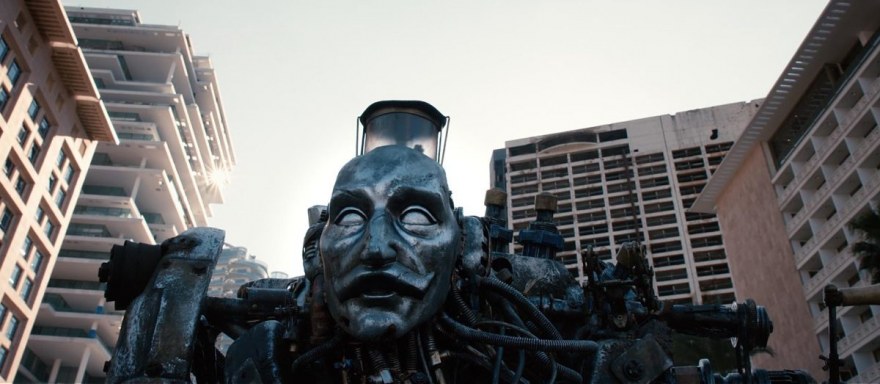Night cap with Last Days of the Man of Tomorrow
An interview with Fadi Baki, director of Last Days of the Man of Tomorrow
We get a sense that Manivelle symbolises or embodies aspects of Lebanon’s history since its independence. Would that be right to say? What were your intentions with the robot?
To some extent, yes: Le Nouvel Homme is the loaded gift that France bestows upon its colony that so this gift becomes a symbol and portent of things to come- but I was not interested in telling a purely symbolic parable or, worse yet, a transposition of the history of the country onto a robot. Instead I was intrigued by the weight of that symbol; the weight of a promise of great things and what it can do to a character.Whenever I talk about Manivelle I always describe him as a child star, one that was born into fame and constantly struggling with the weight of that hyperreality. Sure, a walking, talking robot would be a miracle of technology, but I am more interested in how that informs its actions, how those actions impact those near to him, and what is the cost of that impact. The robotic nature thus provided a chance to see how a character like this would carry that weight into perpetuity.
How did you go about creating Manivelle? Can you talk us through the filming processes a little?
Narratively, Manivelle’s story took many forms as I spent several years rewriting the script to adapt the original intentions for the characterto the scope of a short film. While the core of Manivelle remained the same, we experimented with multiple ways of expressing that character depending on what part of history was available to us production-wise. This process was as challenging as it was interesting, sculpting with sampled historical events meant that the more research we did the more interesting fragments we would find to buttress the story. Production-wise, I worked closely with Omar Khouri, the concept artist and illustrator for the film, to use the form of the robot to illustrate the differing mentalities of each epoch. Le Nouvel Homme arrives as this early-century clockwork wonder, an oriental vision of what the Arab man should look like according the French, fez, sherwal and all,and continues to change as he gets modified throughout his life until he ends up a giant hulking mess of fixes upon fixes.Manivelle was to be like a tortoise, carrying his life on his back, his body evidence of the things he’d done in his life. Our first impulse in creating Manivelle for the film was to do it using computer graphics, shooting with a stand-in and then compositing the robot as a 3D computer-generated character in post. Teaming up with the incredible Chris Creatures workshop allowed us to create the character of Manivelle practically, using a combination of life-size animatronics, old-school puppetry and a mix of CG effects. This suddenly meant that we had Manivelle present on set, with the actors able to interact directly with him. This also meant that we could take Manivelle out onto the streets of Beirut and get natural reactions from the people, which ended up changing the format of the film drastically.
What hurdles did you face? Physical, financial etc.
Ummm, all of them? The film took four years to make, and halfway through I lost the ability to sleep anymore. The ambitions of the film far outstrip the scope of a short film as it required a complex shoot with a main character that was a giant, unweildy special effect, access to archival material (notoriously expensive and difficult to clear), and extensive post-production work. After convincing everyone that we could do this, I arrived at the shores of post-production and lost hope. Trying to make all these elements work together came crashing down our heads during editing and the script we shot had to be thrown out the window and rewritten in post. This was when I felt like I had foolishly convinced everyone that we could do this and then captained ship straight to the bottom of the sea. It was with the patience of the producers and our wonderful editor, Zena Abul Hosn, that we were able to repurpose what we had shot and stitch it back together into something workable.
What do you hope the audience will get out of it?
It has been very interesting to see how audiences from different cultural backgrounds relate to the film as it tells a very culturally specific story to Lebanon. But while some might miss a few cultural references and in-jokes here and there, the heart of the film is a very human story of a broken friendship. For me, the very human failures of Manivelle are what keep drawing me back to him when I watch it these days, a character that somehow outgrew the words on the page and forced me to like him. Sure, there is a lot of fun to be had resampling history and watching an automaton interact with characters from our past,but I would hope the audience walks out conflicted on how to view this character.
Would you say that the short film format has given you any particular freedom?
In some ways a short film can be anything as audiences make allowances for the format that they don’t for features.This coupled with lack of commercial requirements gives the filmmakers free rein to craft the film they have in their mind with less attention paid to how this would have to be marketed. And even though we were warned about pushing ourselves right against the maximum time limit for a short, bringing the running time of the film at half an hour, we have found that audiences and festivals (ok, not all of them) were amenable to it.I don’t think that you can have this kind of flexibility in feature films.
Last Days of the Man of Tomorrow was shown in International Competition.








